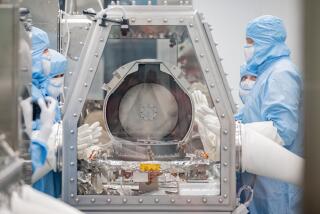Study: Asteroid impact ‘final straw’ for the dinosaurs
It’s been more than 30 years since UC Berkeley researchers first suggested that the extinction of the dinosaurs was probably linked to a massive comet or asteroid impact, known as Chicxulub, off the Yucatan coast. The idea was that the collision from space, which left a 110-mile-wide crater off the coast of Mexico, would have cast off debris that wrapped all the way around Earth, altering the climate and resulting in the global extinction.
But that story hasn’t passed muster everywhere. Because different methods of estimating when the extinction and the impact occurred have yielded different answers -- some studies concluded that the asteroid hit as much as 300,000 years before dinosaurs went extinct -- some people have argued that other circumstances, including volcanic eruptions or climate change, must have had more to do with the dinosaurs’ end than a whopper of an asteroid.
Now, using highly refined methods of determining the ages of rocks, another team from Berkeley has demonstrated that the extinction and the impact occurred at almost exactly the same time: just over 66 million years ago. They reported their findings (abstract free, subscription required for full text) Thursday in the journal Science.
“The impact was clearly the final straw that pushed the Earth past the tipping point,” said study lead author and UC Berkeley earth scientist Paul Renne, in a statement. “We have shown that these events are synchronous to within a gnat’s eyebrow.”
To arrive at the more accurate dates, Renne and his team looked at isotopes of argon in rocks created by the Chicxulub impact, known as tektites, found in Haiti. The scientists also used the dating technique to assign an age to altered volcanic ash deposits from the Hell Creek Formation in Montana that are known to coincide with the boundary between the Cretaceous period, when dinosaurs like Tyrannosaurus rex and Velociraptor still roamed Earth, and the Paleogene period, when they disappeared.
The results showed that the impact and the extinctions happened at essentially the same time, within the range of uncertainty in the measurements. In their paper, the scientists suggested that brief cold snaps in the late Cretaceous period had already put stress on “a global ecosystem that was well adapted to the long-lived preceding Cretaceous hothouse climate.” The asteroid pushed the ecosystem over the edge, they said.
The new dating technique doesn’t resolve all of the questions that remain about dinosaur extinction, wrote University of Bremen climate researcher Heiko Pälike, in an article accompanying the study (abstract available here.)
Pälike, who was not involved in the UC Berkeley research, wrote that the next challenge would be to apply the new dating techniques to learn more about volcanism during the period and its influence on the mass extinction.







